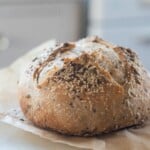
Seeded Sourdough Bread
Introducing Seeded Sourdough Bread - an earthy, nutty flavored loaf, bursting with whole wheat flour goodness, long-fermented sourdough tang, and roasted seeds upon roasted seeds.
Servings 12
Calories 200kcal
Ingredients
- 250 grams unbleached all purpose
- 100 grams whole wheat flour
- 125 grams bread flour
- 100 grams sourdough starter active and bubbly
- 350 grams water
- 8 grams salt
- 1/4 cup salted sunflower seeds
- 1/4 cup salted pumpkin seeds
- 1 tablespoon whole flax seeds
- 1 tablespoon sesame seeds
Topping
- 1 tablespoon pumpkin seeds
- 1 tablespoon sunflower seed
- 1 teaspoon flax seeds
- 1 teaspoon sesame seeds
Instructions
- Feed your sourdough starter 4-12 hours before starting the bread, allowing it to become active and bubbly.
- Combine warm water and flour in a large bowl, followed by a brief rest of 30 minutes for the water to hydrate the flour. This is called an autolyse.
- An autolyse is a short rest of the ingredients, allowing the flour to be fully hydrated by the water. It might seem like an unnecessary step, but it makes a significant difference in the texture of your bread later.
- An autolyse also gives you a head start on gluten development when you move on to the stretch and folds.
- Add in your sourdough starter, pouring it somewhat evenly over the flour and water.
- Sprinkle salt on top.
- Mix by hand for about 5 minutes to bring the dough together.
- Cover your dough with a damp towel or plastic wrap and let rest for 30 minutes.
Stretch And Folds
- In order to develop the gluten and achieve a nice rise, you'll now do 6 rounds of stretching and folding.
- Note: On the fifth round, add the seed mixture on top of the dough. You'll incorporate the seeds pretty thoroughly during the next couple stretch and folds.
- First 3 stretch and folds - every 15 minutes.
- Last 3 stretch and folds - every 30 minutes.
Bulk Fermentation
- After the final stretch and fold, place your dough in a lightly oiled bowl and cover with a damp tea towel or plastic wrap.
- Keep in a warm place for 8-12 hours, by which point, it should have doubled in size. How long your bulk fermentation will take depends on several factors, like the temperature of your home and the maturity of your starter.
Shaping & Final Proof
- Prepare a lightly floured surface as a workspace.
- Shape dough into a ball by gently spinning it toward you, or gently pushing it away from you, creating mild tension in the dough.
- Set out at room temperature for 15-20 minutes, uncovered. We want the dough to develop a light skin, which will keep it from sticking to your tea towel during the final proof.
- Now turn over your dough (I find a bench knife or bench scraper to be super helpful here), and shape again.
- Fold opposite sides in, to meet in the middle, pressing in the center with your fingertips to hold it in place.
- Transfer the shaped dough to your lightly floured Banneton basket or tea towel-lined bowl with the seam side up.
- Cover with plastic wrap and refrigerate for 12-15 hours.
Bake
- Begin by preheating your Dutch oven to 500 degrees for one hour.
- Remove proofed dough from refrigerator. It should have risen still further during this time. Cold bread dough is also much easier to score than at room temperature.
- Transfer your loaf to the counter or workspace of choice, carefully flipping it over so that the seam-side is now facing down.
- Brush the top of the loaf with water, then sprinkle your combination of seeds evenly across. The water really helps the seeds to stay in place. I love a full layer of seeds on top, as they add to the delightfully crunchy crust.
- Score with a razor. Need some ideas on scoring?
- Lightly flour the bottom of your scorching hot Dutch oven (or parchment paper) and transfer your bread dough to it.
- Bake for 20 minutes, covered.
- Reduce the oven temperature to 475 and remove the lid, baking for an additional 25 minutes or until beautifully brown.
- Cool your fantastic, seeded sourdough loaf on a wire rack for 1 to 2 hours before slicing.
Notes
Nutrition
Calories: 200kcal | Carbohydrates: 33g | Protein: 7g | Fat: 5g | Saturated Fat: 1g | Polyunsaturated Fat: 3g | Monounsaturated Fat: 1g | Trans Fat: 0.01g | Sodium: 282mg | Potassium: 121mg | Fiber: 3g | Sugar: 0.3g | Vitamin A: 2IU | Vitamin C: 0.1mg | Calcium: 24mg | Iron: 2mg